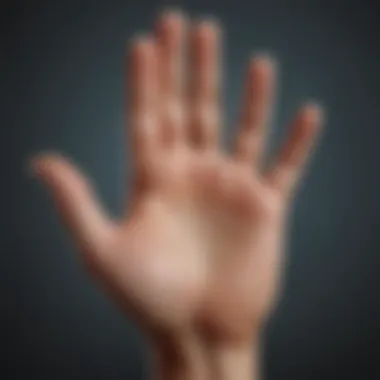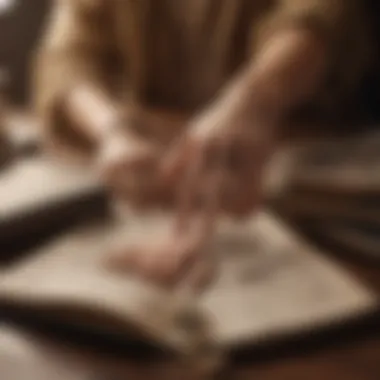Unlocking the Future: A Guide to Palmistry Insights


Intro
Palmistry, the esoteric art of hand reading, offers insights into one’s character and potential future. This ancient practice has captivated individuals across cultures for centuries. Delving into the lines, shapes, and mounts on the palm can reveal significant information. In this exploration, we will unveil the core aspects of palmistry, guiding you on how to interpret your own hand and understand the messages it holds.
Understanding the Zodiac
Overview of Zodiac Signs
The Zodiac consists of twelve signs, each representing distinct personality traits and qualities. These signs derive from constellations found along the ecliptic, symbolizing different attributes tied to human experiences.
Sign Traits and Characteristics
Each Zodiac sign carries specific traits that shape an individual's interface with the world. For instance:
- Aries: Courageous, determined
- Taurus: Reliable, patient
- Gemini: Adaptable, outgoing
- Cancer: Intuitive, emotional
This diverse array of characteristics allows a richer understanding of interpersonal dynamics.
Elemental Qualities
The twelve signs are categorized into four elements: Fire, Earth, Air, and Water. Each element influences the nature of its signs, affecting interpersonal relationships and natural inclinations. For example:
- Fire signs (Aries, Leo, Sagittarius) are known for their energy and passion.
- Earth signs (Taurus, Virgo, Capricorn) represent practicality and stability.
In studying these qualities, a deeper comprehension of oneself and others can emerge.
Astrological Insights
Current Astrological Trends
Understanding today's astrological trends empowers individuals to navigate their lives more effectively. Current planetary positions highlight areas of growth or challenges. Keeping abreast of these trends can sharpen one’s decision-making skills.
Influence of Celestial Events
Celestial events such as eclipses, retrogrades, and full moons significantly influence personal and collective experiences. Observing these patterns helps in analyzing potential outcomes and emotional responses. Individuals often reflect on their personal charts during these events for enhanced clarity.
How to Interpret Your Birth Chart
Your birth chart is a map of the sky at the exact moment of your birth. It reveals positions of planets across Zodiac signs, which contribute to your unique traits. Learning to interpret your chart provides valuable insights, enhancing personal growth and understanding.
Horoscope and Predictions
Monthly or Weekly Forecasts
Horoscopes offer periodic insights, guiding individuals through upcoming challenges and opportunities. These forecasts can inform personal and professional decisions, offering clarity during uncertainty.
Personalized Horoscope Reading
Going beyond general readings, personalized horoscopes account for one's specific birth details. This deeper analysis can deliver more targeted guidance and reveal hidden aspects of character.
Compatibility Readings based on Zodiac signs
Zodiac compatibility assessments are essential for understanding relationship dynamics. Analyzing the elemental and sign traits can reveal potential areas of harmony and conflict, facilitating better interpersonal understanding.
Remember: Palmistry complements astrology, providing a well-rounded perspective on life’s potential paths. Incorporating both practices can enrich one’s journey of self-discovery and enlightenment.
Foreword to Palmistry
Palmistry, often seen as a mystical or esoteric practice, offers a unique window into personal insight and potential. This ancient art examines the hand to uncover potential personality traits and life paths. For those who delve into its intricacies, palmistry can serve various purposes. It can act as a tool for self-reflection, a way to engage with one's inner self, or a method for understanding relationships.
Understanding Palmistry
Palmistry, also known as chiromancy, hinges on the belief that interpreting the lines, shapes, and features of the hand can reveal significant information about an individual's character and destiny. The major lines, such as the heart line, head line, life line, and fate line, play a crucial role in this practice. Each line symbolizes different aspects of life - emotional, intellectual, and existential.
Additionally, the mounts and overall hand shape can further refine an interpretation. These features not only provide insight but also allow for a deeper exploratory process regarding personal growth and life choices. The open-ended nature of palm readings can lead to profound discussions about one's direction in life.
It is essential to note that palmistry is not purely deterministic. It emphasizes a more nuanced view of fate, allowing for free will in the interpretation of one’s potential. Therefore, while some may view palmistry as destiny's script, others see it as a reflected image of their choices.


Historical Context
The origins of palmistry trace back thousands of years, spanning multiple cultures. Historical records indicate its practice in ancient India, China, and Greece. It gained considerable prominence during the Renaissance, where it merged with astrology and other metaphysical practices.
In India, palmistry is deeply intertwined with holistic health, often linked to Ayurvedic philosophies. Ancient texts like the Samhita elaborate on how various lines can influence physical and emotional health.
Conversely, in the Western world, figures like Aristotle and later, astrologers of the Renaissance contributed to its acceptance and evolution. Palmistry has often fluctuated in public perception. At times, it has been regarded as a serious practice, while at other instances, it has faced skepticism and dismissal.
Understanding this historical context enriches one's engagement with palmistry, offering perspective on its cultural significance. As the practice continues to evolve, it remains a captivating area of exploration for those seeking personal insight.
Palmistry is not merely a reflection of fate; it is a narrative shaped by choices and experiences.
Part One: The Anatomy of the Hand
Understanding the structure of the hand is fundamental in palmistry. Part One delves into the anatomy, highlighting key features that reveal much about a person’s character and potential future. The lines, mounts, and shapes of the hand provide critical insights and serve as the backbone of any palm reading. Analyzing these elements brings forth a deeper understanding of human traits and behaviors, making it easier to interpret one's life path.
Major Lines
The major lines on the palm reflect significant aspects of an individual's life. Each line serves a unique purpose and showcases different traits. Their presence and depth can affect interpretations, making them pivotal in palmistry.
Heart Line
The Heart Line illustrates emotional aspects of life. It is typically located at the top of the palm, curving around the base of the fingers. A long and deep Heart Line is often linked with strong emotional connections and stability in relationships.
Its significance lies in its ability to indicate the subject's approach to love and feelings. A wavy Heart Line might suggest emotional fluctuations. Meanwhile, a straight line could indicate a more reserved character. The Heart Line's characteristics make it a popular focus for those seeking insights into romantic compatibility and emotional health.
Head Line
The Head Line is essential for understanding intellectual pursuits. Positioned just below the Heart Line, it signifies thought processes, decision-making abilities, and creativity. A long and clear Head Line is generally associated with clarity in thought and reasoning power.
This line is crucial in determining analytical skills, with a break or fork in the line often symbolizing shifts in thought patterns. Its prominence makes it valuable for individuals focused on personal development and academic achievements.
Life Line
The Life Line wraps around the base of the thumb and reflects physical vitality and general life path. Contrary to popular belief, it does not indicate the length of life but rather the quality of life. A deep, confident Life Line can suggest strong health and an overall sense of well-being.
Various factors, such as breaks or changes in the line, may signify altered life circumstances. Thus, the Life Line serves as a central focus for those examining their health and lifestyle decisions.
Fate Line
The Fate Line, often running vertically up the center of the palm, reveals aspects relating to life events and career. Its visibility can indicate how strongly a person's life is influenced by external forces. A dominant Fate Line may point towards a life path directed by fate, while a faint line could suggest a more self-determined journey.
This line's uniqueness lies in its relationship to personal circumstance, whether shaped more by interventions of the environment or one's choices.
Minor Lines
Minor lines complement the major ones and provide additional insights. Although they may not hold the same weight, their presence can add depth to the overall reading.
Mercury Line
The Mercury Line is associated with communication skills and social interactions. Found on the side of the palm, it can reveal one's adeptness in addressing social situations. A pronounced Mercury Line suggests strong oratory skills, making it valuable for careers in communication and public relations.
Sun Line
The Sun Line indicates fame, success, and creativity. Its presence near the base of the ring finger can symbolize recognition and achievements in life. A clear Sun Line suggests a satisfying creative outlet or professional recognition, important for those driven by personal accomplishment.
Marriage Lines
Located on the edge of the hand, Marriage Lines reflect relationship commitments and partnerships. Their formation and depth can showcase the quality of romantic relationships and their timelines. This line provides insights into personal connections, making it particularly relevant for those examining their partnership dynamics.
Mounts of the Hand
The mounts located at the base of the fingers each symbolize various traits and characteristics.
Mount of Venus
The Mount of Venus indicates love and affection. A pronounced mount suggests a person who values relationships deeply. This trait often brings warmth, charm, and strong emotional ties. If this mount is less developed, it could hint at a more independent personality.
Mount of Jupiter


The Mount of Jupiter reflects ambition and leadership qualities. A strong presence here suggests a person driven to achieve their goals. Individuals with a dominant Mount of Jupiter are often seen as natural leaders, making it significant for those interested in career advancement.
Mount of Saturn
The Mount of Saturn represents discipline and responsibility. A pronounced mount can indicate a focus on structures and long-term goals. It highlights the importance of hard work and reliability, essential traits for individuals pursuing serious endeavors.
Mount of Apollo
A prominent Mount of Apollo reveals creativity and self-expression. This mount corresponds with artistic talents and the pursuit of beauty. Individuals with a robust Mount of Apollo may find success in the arts, making it particularly relevant for creatives.
Mount of Mercury
The Mount of Mercury signifies communication and wit. Its prominence suggests an affinity for cleverness and adaptability in social situations. This makes it vital for individuals engaged in negotiation or public speaking.
Hand Shapes
Hand shapes provide initial insights into personality traits. Different shapes correlate with unique characteristics that can guide interpretation.
Earth Hands
Earth Hands are typically square-shaped with a broad palm and short fingers. People with this hand shape are often practical and grounded. They value realism, which may lead them to successful careers in business or management.
Air Hands
Air Hands are defined by long fingers and a rectangular palm. This shape indicates strong intellectual capabilities and creativity. Such individuals often excel in fields such as communication or the arts.
Fire Hands
Fire Hands showcase a rectangular palm with short fingers. This shape denotes a passionate and energetic personality. People with this hand shape might thrive in leadership roles, demonstrating charisma and assertiveness.
Water Hands
Water Hands are characterized by long palms and long fingers. This shape reflects sensitivity and emotional depth. People with Water Hands may be intuitive and empathetic, often drawn to helping professions or creative outlets.
In summary, understanding the anatomy of the hand is paramount for anyone interested in palmistry. Each element plays a crucial role in delivering a comprehensive reading, revealing insights into human behavior and potential life experiences.
Part Two: Interpreting Your Hand
Interpreting your hand is an essential aspect of palmistry that provides profound insight into personal traits, life experiences, and potential future paths. This part dives into the techniques necessary for discerning the meanings behind the major lines, mounts, and the integration of these elements for a more holistic comprehension. Each segment of your palm tells a unique story, and understanding how to read these signs can empower you in various aspects of life.
Reading the Major Lines
The major lines are the cornerstone of palmistry. They reveal vital aspects of an individual’s emotional, intellectual, and physical life. These lines are the Heart Line, Head Line, Life Line, and Fate Line, each with its distinct significance:
- Heart Line: This line reflects emotional depth and romantic inclinations. The length, curvature, and clearness can indicate how a person loves and receives love.
- Head Line: This line represents intellect, reasoning, and decision-making. A long and deep Head Line often suggests clarity of thought and strong mental skills.
- Life Line: Contrary to popular belief, it does not predict the length of life. Instead, it signifies vitality and major life changes. The presence of breaks can suggest significant life events.
- Fate Line: Not every hand has this line, but when present, it addresses how external influences can direct life choices. It may indicate career direction and destiny.
Understanding these major lines helps individuals reflect on their emotional states and life journeys. Individuals can discover patterns or themes in their experiences through such interpretations, offering a clear framework to foster self-awareness.
Interpreting the Mounts
The mounts of the hand are the fleshy areas located at the base of each finger and the palm. These mounts represent different traits and aspects of personality. The main mounts include:
- Mount of Venus: Associated with love and passion, its prominence reflects one’s affection and sensuality.
- Mount of Jupiter: This mount is linked to ambition and leadership. A well-developed Mount of Jupiter suggests a strong drive for success.
- Mount of Saturn: It represents practicality and responsibility. A pronounced mount indicates a serious approach to life.
- Mount of Apollo: Also known as the Mount of the Sun, it is connected with creativity and joy. An elevated mount suggests an appreciation for beauty and art.
- Mount of Mercury: This mount correlates with communication skills. A prominent Mount of Mercury suggests strong verbal abilities and cleverness.
These mounts, when observed carefully, reveal not just innate characteristics but also personal affinities and inclinations towards specific life paths. Interpreting them alongside the major lines can add depth to the reading.
Combining Elements for a Comprehensive Reading
A comprehensive reading involves more than isolated assessments of lines or mounts. It requires a synthesis of various elements. Here are key approaches:
- Contextual Analysis: Look at how major lines interact with mounts. For instance, if the Heart Line shows a tendency towards romanticism while the Mount of Venus is prominent, this may confirm strong relational qualities.
- Alignment of Shapes and Lines: Hand shape plays a significant role. For example, an Earth Hand with a deep Life Line may prioritize stability, while an Air Hand with a strong Head Line may value intellectual pursuits.
- Observing Anomalies: Irregularities, such as breaks or forked lines, can provide additional layers of meaning. They often indicate challenges or unique life experiences.
When combining these aspects, the reader develops a richer, more nuanced understanding of the individual’s life potential. This holistic approach allows for tailored insights that can guide future decisions.
By embracing these varied interpretations, one can embark on a journey of self-discovery and personal growth through the art of palmistry.
Through careful study and practice, an interpreter can gradually refine their skills. The ultimate goal is to empower individuals through knowledge of their own hands, shedding light on their unique paths in life.


Palmistry in Modern Context
Palmistry, though ancient, remains relevant in today's society. It serves as a bridge between tradition and contemporary understanding. The significance of palmistry in the modern context lies in its ability to provide insights into personality, choices, and potential future events based on the distinct lines and shapes present in an individual's hand. This analysis not only enriches the understanding of oneself but also enhances interpersonal relationships.
Scientific Perspectives
The relationship between palmistry and science is complex. Many skeptics argue that palmistry lacks empirical support and falls in the realm of pseudoscience. However, there are psychological aspects that align with its practice. For instance, palmistry can serve as a tool for self-exploration, allowing individuals to reflect on their lives and decisions.
Research in psychology shows that self-reflection contributes positively to mental well-being. The act of analyzing one’s hand might spark meaningful introspection about personal life paths, values, and aspirations. While there may be no scientific evidence to predict the future through hands, the benefits of engaging with palmistry can lead to enhanced self-awareness, which is a valuable aspect of modern living.
Furthermore, cognitive psychology suggests that belief in these systems can have real effects on personal outcomes. If individuals approach palmistry with an open mind, they might find it useful for clarity and motivation.
Cultural Variations
Palmistry varies significantly across cultures. In Western societies, it is often seen as a form of entertainment or curiosity. In contrast, regions like India approach it with a more serious perspective, embedding it into their spiritual practices and societal traditions.
Cultural interpretations of different lines and mounts vary, reflecting unique beliefs and values. For example, in Indian palmistry, the practice is not only concerned with the lines but also incorporates a deep understanding of astrology and cosmic influences. This holistic view presents a broader framework of interpreting life events.
In Japan, palmistry intertwines with other esoteric practices and focuses more on the individual's unique life path rather than predictive analysis. The diverse approaches to palm reading across cultures illustrate the adaptability and significance of this practice in addressing the curiosities and beliefs of different populations.
Common Myths and Misconceptions
Understanding the common myths and misconceptions surrounding palmistry is crucial for a well-rounded exploration of this ancient practice. Many people hold beliefs about palm reading that are not only incorrect, but can also hinder their ability to engage deeply with this art. By addressing these fallacies, we can better appreciate the complexities of palmistry and its practical applications.
Debunking Myths
One prevalent myth about palmistry is the idea that it is purely a superstitious practice. Critics often dismiss it without understanding its roots and methodologies. While skepticism is a healthy attitude, it is essential to recognize the historical significance and cultural relevance that palmistry holds.
Another common misconception is that one can predict specific events with absolute certainty. Palmistry offers a framework for understanding tendencies and traits rather than definitive outcomes. Well-practiced palmists emphasize that it provides guidance based on one's character rather than fixed destinies.
- Myth: Palmistry is only for fortune-tellers.
- Reality: Many use it for self-reflection and personal growth.
- Myth: Only specific hand shapes can reveal accurate future insights.
- Reality: Every hand has its unique value and can provide meaningful information.
Understanding Limitations
Recognizing the limitations of palmistry is just as vital as understanding its merits. It should not be viewed as a replacement for other forms of guidance or introspection, such as therapy or coaching. Palmistry can complement these methods but should not solely dictate life choices.
Individuals interested in palmistry should approach it with an open mind, understanding that it is just one lens for exploring the self. Its insights should be taken as a part of a broader self-discovery journey, allowing for more informed decision-making while understanding that no single reading provides the full picture.
Practical Applications of Palmistry
Palmistry offers profound insights that can enhance one’s life beyond mere fortune-telling. In this sector, we explore various practical applications: self-reflection, guiding relationships, and enhancing decision-making. Each of these aspects serves unique purposes, fulfilling a deep-seated human desire for understanding and personal growth.
Self-Reflection and Growth
Palmistry provides a framework for self-exploration. By analyzing hand features, individuals can gain insight into their personalities, strengths, and weaknesses. When one takes the time to reflect on their palm's major lines and mounts, a clearer image of their character emerges.
A notable benefit is the potential for personal growth. Understanding specific traits linked to the lines in one’s hand encourages individuals to make informed choices in life. For instance, those with a pronounced Heart Line may realize their emotional depth and, as such, invest more time in nurturing relationships. This enhanced self-awareness often leads to positive changes and more fulfilling life paths.
Guiding Relationships
The ability to discern relationship dynamics is another crucial application of palmistry. Relationship health can be assessed by noting aspects such as the Marriage Lines and the overall texture and shape of the hand. Even if palmistry is not viewed as absolute, it provides a roadmap to understanding interpersonal connections.
For example, those with prominent Sun Lines might excel in social interactions and peer relationships. This knowledge can guide how they engage with others, tailoring their approach based on their inherent traits. Moreover, recognizing partners’ palm features can aid in fostering stronger connections, enabling couples to appreciate each other's personalities deeply.
Understanding one’s hand truly offers a lens into potential growth in personal and romantic relationships.
Enhancing Decision-Making
The insights gained through palmistry can inform decision-making processes. When individuals have a grasp of their natural propensities, they can align their choices with their strengths, ensuring a more harmonious life. For example, someone with a well-defined Fate Line might prioritize career-oriented decisions, while those with clear Life Lines could focus on health and well-being.
Additionally, during critical life decisions, referencing palmistry may lead to well-rounded considerations of potential outcomes. By synthesizing palm readings with personal values, individuals can navigate choices with enhanced clarity and confidence.
In summary, the applications of palmistry extend beyond the mystical. It serves as an insightful guide to self-discovery, enhancement of relationships, and improved decision-making. Engaging with one’s hand translates to personal empowerment and conscious living.
The End
In this article, we explored the intricate world of palmistry and its potential to illuminate one's life path. The practice of examining the hand, especially the lines and mounts, serves as a tool for self-reflection and growth. Understanding how to read these aspects can lead to deeper insights regarding personal relationships, decision-making, and individual development.
Reflections on Palmistry
Palmistry has a rich history and culture, embodying the belief that our hands can reflect our personality traits, emotional states, and life experiences. Through learning to interpret the significant lines, such as the heart line and head line, one may derive insights that can guide them in their personal journey. Although some critics hold skepticism about palmistry's efficacy, many practitioners appreciate it as a meaningful exercise in self-discovery. By viewing palmistry not merely as a prediction tool but rather as a means to understand our tendencies and choices, individuals can grasp its relevance in modern life.
Invitation to Explore
As you close this exploration of palmistry, consider delving deeper into this ancient art. Observe your hands and, perhaps, those of your friends to start your own practice of reading palms. Whether you choose to explore further through literature, connect with practitioners in communities found on platforms like reddit.com, or even join groups on facebook.com, the journey into palmistry can enrich your perspective. Allow curiosity to guide you, and remember, each hand tells a unique story that can be contextually dissected to unveil new dimensions of understanding.







